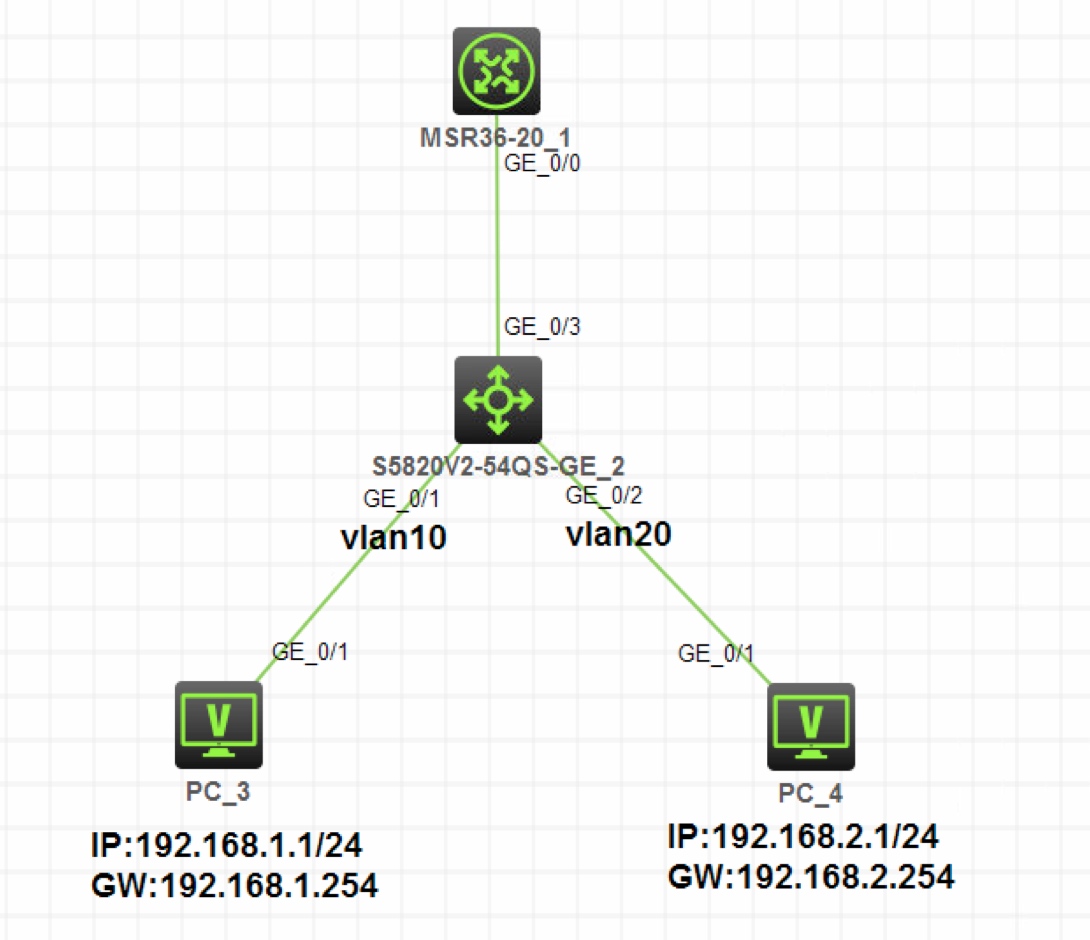单臂路由实验
实验拓扑

注:如无特别说明,描述中的 R1 或 SW1 对应拓扑中设备名称末尾数字为 1 的设备,R2 或 SW2 对应拓扑中设备名称末尾数字为 2 的设备,以此类推
实验需求
- 按照图示为 PC3 和 PC4 配置 IP 地址和网关
- PC3 属于 Vlan10,PC4 属于 Vlan20,配置单臂路由实现 Vlan10 和 Vlan20 三层互通
- PC3 和 PC4 可以互通
实验解法
- PC 配置 IP 地址部分略
PC3 属于 Vlan10,PC4 属于 Vlan20,配置单臂路由实现 Vlan10 和 Vlan20 三层互通
分析:用单臂路由实现 Vlan 间三层互通,需要把 SW2 连接 R1 的接口配置为 Trunk,并允许 Vlan10 和 Vlan20 通过
R1 连接 SW2 的接口上要开启子接口,分别作为 Vlan10 和 Vlan20 的网关。这里规划 g0/0.1 子接口作为 Vlan10 的网关,IP 地址就是192.168.1.254/24,g0/0.2 子接口作为 Vlan20 的网关,IP 地址就是192.168.2.254/24
R1 的子接口上为了能够识别 SW2 的 Trunk 端口发送的 802.1Q 帧,还需要开启 dot1q 识别并绑定相应 Vlan。根据上述分析,g0/0.1 子接口绑定 Vlan10,g0/0.2 子接口绑定 Vlan20
步骤 1:在 SW2 上创建 Vlan10 和 Vlan20,并把 g1/0/1 接口加入 Vlan10,把 g1/0/2 接口加入 Vlan20[SW2]vlan 10 [SW2-vlan10]port g1/0/1 [SW2-vlan10]vlan 20 [SW2-vlan20]port g1/0/2步骤 2:把 SW2 的 g1/0/3 接口配置为 Trunk,并允许 Vlan10 和 Vlan20 通过
[SW2]interface g1/0/3 [SW2-GigabitEthernet1/0/3]port link-type trunk [SW2-GigabitEthernet1/0/3]port trunk permit vlan 10 20步骤 3:在 R1 上创建子接口 g0/0.1,开启 dot1q 识别,绑定到 Vlan10,并配置 IP 地址
192.168.1.254/24[R1]interface g0/0.1 [R1-GigabitEthernet0/0.1]vlan-type dot1q vid 10 [R1-GigabitEthernet0/0.1]ip address 192.168.1.254 24步骤 4:在 R1 上创建子接口 0/0.2,开启 dot1q 识别,绑定到 Vlan20,并配置 IP 地址
192.168.2.254/24[R1]interface g0/0.2 [R1-GigabitEthernet0/0.2]vlan-type dot1q vid 20 [R1-GigabitEthernet0/0.2]ip address 192.168.2.254 24分析:配置结束后,在 R1 上查看路由表,会发现已经产生了到达
192.168.1.0/24网段和192.168.2.0/24网段的直连路由,出接口分别指向各自子接口,证明路由器已经可以对 Vlan10 和 Vlan20 间的数据进行三层转发了[R1]display ip routing-table Destination/Mask Proto Pre Cost NextHop Interface …… 192.168.1.0/24 Direct 0 0 192.168.1.254 GE0/0.1 …… 192.168.2.0/24 Direct 0 0 192.168.2.254 GE0/0.2 ……测试在 PC3 上 Ping PC4 ,可以 Ping 通 PC4
<H3C>ping 192.168.2.1 Ping 192.168.2.1 (192.168.2.1): 56 data bytes, press CTRL_C to break 56 bytes from 192.168.2.1: icmp_seq=0 ttl=254 time=36.000 ms 56 bytes from 192.168.2.1: icmp_seq=1 ttl=254 time=25.000 ms 56 bytes from 192.168.2.1: icmp_seq=2 ttl=254 time=27.000 ms 56 bytes from 192.168.2.1: icmp_seq=3 ttl=254 time=29.000 ms 56 bytes from 192.168.2.1: icmp_seq=4 ttl=254 time=39.000 ms